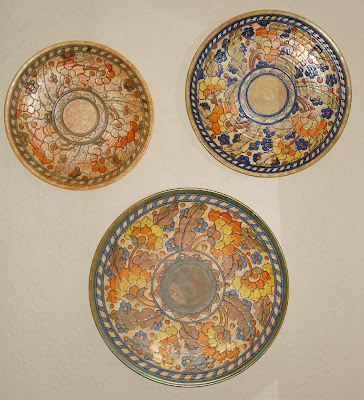Tube-lining: Black
Enamels & Lustres: Primrose yellow, orange, blue & others. The pattern predates the surviving pattern books and consequently there is no reference source for the materials used.
Glaze: Brown mottle with or without green wash
Frequency Ranking: 2/50
Design Date: Late 1932 or early 1933
Production Period: Late 1932 - 1935. Unlikely to be after 1936 except for some wall chargers and specially commissioned items
Pattern Name: Explicitly named in period trade journals and referenced in the Crown Ducal pattern book for pattern 3052
Byzantine was Charlotte’s first popular design for Crown Ducal, it a common pattern, with only Golden Leaves being more easily found. It had a reasonable production run of at least 3 years but has not been seen on the new shapes that were introduced during 1936.
Some wall chargers continued to be made until Charlotte left the company but these appear to be the only shape seen with the younger backstamp styles.
Variations in the intensity of the colour palette used and in the strength of the mottled glaze are typical. Colours can be absent, particularly the yellow in the flowers and the green wash component over the glaze. The leaves may be left uncoloured. A significant variation is a golden yellow version where the primrose colour of the petals is used to replace the green for edges and centres etc, (except for the leaves).
See also patterns 2801 and 3052 which are the same tube-lined design but with distinctively different glazes and enamel colours.
Enamels & Lustres: Primrose yellow, orange, blue & others. The pattern predates the surviving pattern books and consequently there is no reference source for the materials used.
Glaze: Brown mottle with or without green wash
Frequency Ranking: 2/50
Design Date: Late 1932 or early 1933
Production Period: Late 1932 - 1935. Unlikely to be after 1936 except for some wall chargers and specially commissioned items
Pattern Name: Explicitly named in period trade journals and referenced in the Crown Ducal pattern book for pattern 3052
 |
| Pattern 2681 Byzantine |
Byzantine was Charlotte’s first popular design for Crown Ducal, it a common pattern, with only Golden Leaves being more easily found. It had a reasonable production run of at least 3 years but has not been seen on the new shapes that were introduced during 1936.
Some wall chargers continued to be made until Charlotte left the company but these appear to be the only shape seen with the younger backstamp styles.
Variations in the intensity of the colour palette used and in the strength of the mottled glaze are typical. Colours can be absent, particularly the yellow in the flowers and the green wash component over the glaze. The leaves may be left uncoloured. A significant variation is a golden yellow version where the primrose colour of the petals is used to replace the green for edges and centres etc, (except for the leaves).
See also patterns 2801 and 3052 which are the same tube-lined design but with distinctively different glazes and enamel colours.
References of the period:
Pottery Gazette and Glass Trades Review, March 1933 pages 321-325.
Lastly, there is a very fine range of ornamental pieces in a new style of treatment which has been christened “Byzantine.” Of this we illustrate a group of pieces. This is a class of production which no one of cultured taste would hesitate to accept and accord a worthy place in a well furnished household. The pieces are of perfectly plain shapes; and their entire surface is first tube-lined in the clay. The tracery on low relief, thus formed, is then subsequently decorated by the brush in warm colourings. Undoubtedly it is a very smart type of treatment, and one which, we feel sure, will be heartily received by the trade.
Pottery Gazette and Glass Trades Review, March 1933 pages 321-325.
Lastly, there is a very fine range of ornamental pieces in a new style of treatment which has been christened “Byzantine.” Of this we illustrate a group of pieces. This is a class of production which no one of cultured taste would hesitate to accept and accord a worthy place in a well furnished household. The pieces are of perfectly plain shapes; and their entire surface is first tube-lined in the clay. The tracery on low relief, thus formed, is then subsequently decorated by the brush in warm colourings. Undoubtedly it is a very smart type of treatment, and one which, we feel sure, will be heartily received by the trade.
